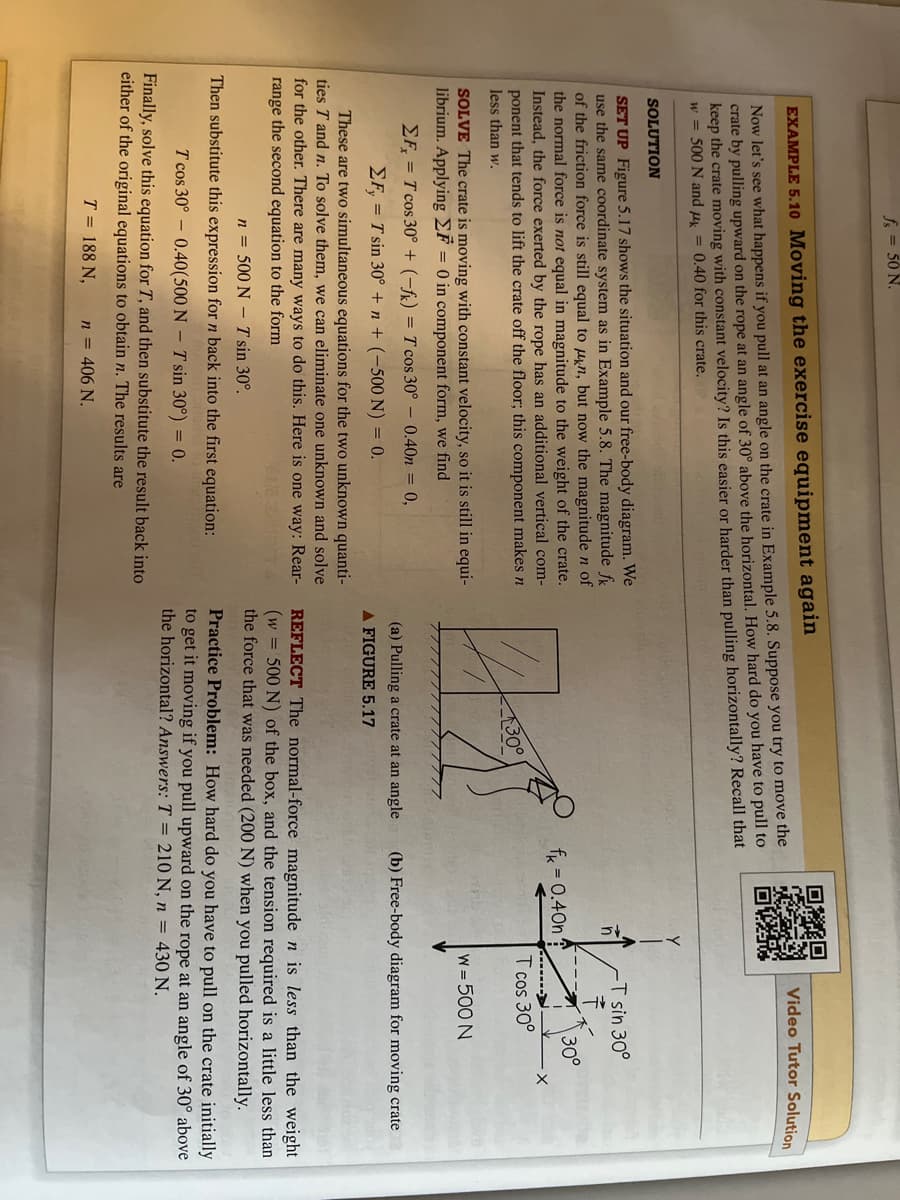How hard do you have to pull on a crate initially to get it moving if you pull upward in the rope at an angle of 30 degrees above the horizontal? Answers T=210N, n=430N Image had background info for practice problem.
How hard do you have to pull on a crate initially to get it moving if you pull upward in the rope at an angle of 30 degrees above the horizontal? Answers T=210N, n=430N Image had background info for practice problem.
Related questions
Question
How hard do you have to pull on a crate initially to get it moving if you pull upward in the rope at an angle of 30 degrees above the horizontal?
Answers T=210N, n=430N
Image had background info for practice problem.

Transcribed Image Text:50 N.
EXAMPLE 5.10 Moving the exercise equipment again
Now let's see what happens if you pull at an angle on the crate in Example 5.8. Suppose you try to move the
crate by pulling upward on the rope at an angle of 30° above the horizontal. How hard do you have to pull to
keep the crate moving with constant velocity? Is this easier or harder than pulling horizontally? Recall that
w = 500 N and μ = 0.40 for this crate.
SOLUTION
SET UP Figure 5.17 shows the situation and our free-body diagram. We
use the same coordinate system as in Example 5.8. The magnitude f
of the friction force is still equal to kn, but now the magnitude n of
the normal force is not equal in magnitude to the weight of the crate.
Instead, the force exerted by the rope has an additional vertical com-
ponent that tends to lift the crate off the floor; this component makes n
less than w.
SOLVE The crate is moving with constant velocity, so it is still in equi-
librium. Applying F = 0 in component form, we find
ΣF = T cos 30° + (-fk) = T cos 30° - 0.40n = 0,
EF, = T sin 30° +n + (-500 N) = 0.
These are two simultaneous equations for the two unknown quanti-
ties T and n. To solve them, we can eliminate one unknown and solve
for the other. There are many ways to do this. Here is one way: Rear-
range the second equation to the form
era sutiprs
n = 500 N T sin 30°.
Then substitute this expression for n back into the first equation:
T cos 30° 0.40(500 N T sin 30°) = 0.
Finally, solve this equation for T, and then substitute the result back into
either of the original equations to obtain n. The results are
T = 188 N,
n = 406 N.
47
30°
(a) Pulling a crate at an angle
A FIGURE 5.17
Y
n
f = 0.40n
Video Tutor Solution
-T sin 30°
T cos 30°
30°
w=500 N
·x
(b) Free-body diagram for moving crate
REFLECT The normal-force magnitude n is less than the weight
(w = 500 N) of the box, and the tension required is a little less than
the force that was needed (200 N) when you pulled horizontally.
Practice Problem: How hard do you have to pull on the crate initially
to get it moving if you pull upward on the rope at an angle of 30° above
the horizontal? Answers: T = 210 N, n = 430 N.
Expert Solution
This question has been solved!
Explore an expertly crafted, step-by-step solution for a thorough understanding of key concepts.
Step by step
Solved in 2 steps with 1 images
